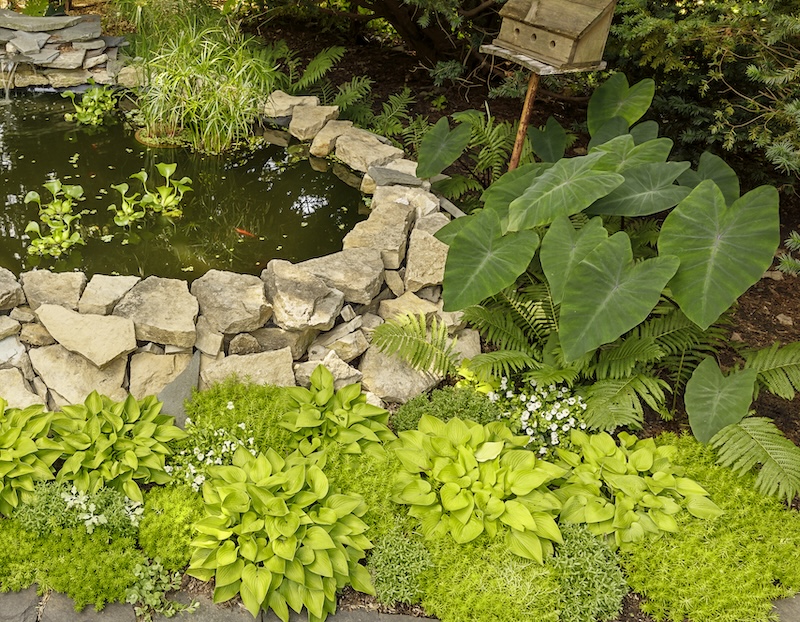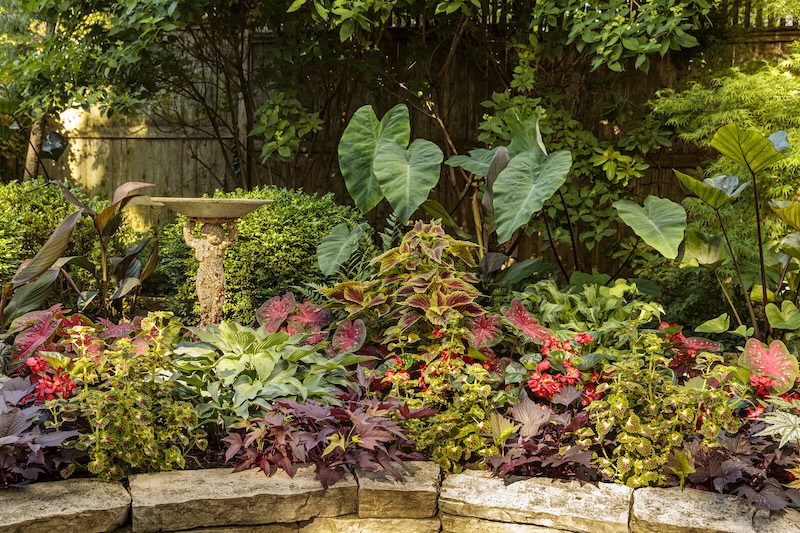Elephant ears are plants grown for their large, arrow- or heart-shaped leaves. The common name refers to plants in the genera Colocasia, Alocasia, and Xanthosoma, all of which have similar appearances and growth requirements. These plants are native to tropical regions of South America, Asia, and Australia, where they often grow in tropical forests or near water.
Elephant ears come in a variety of leaf colors, such as green, purple, and variegated. While their foliage steals the show, elephant ears occasionally bloom with creamy white or yellow flowers consisting of a spade and a spadix, similar to peace lily flowers. Elephant ears can be grown in containers, tropical gardens, shade gardens, borders, and water gardens. They can even be grown as a houseplant with bright, indirect light.

Elephant ears can grow anywhere from 2 to 8 feet tall in full sun to partial shade. Darker-leaved varieties perform best in full sun, whereas green-leaved varieties prefer part shade. Elephant ears need consistently moist soil and frequent fertilization to thrive. They can even be grown as emergent plants, with their roots in shallow water or along the edges of water features. While they are perennials in zones 8-11, they can be dug up and stored in a dark, dry place over winter in cooler regions.
Shrubs To Plant With Elephant Ear
Elephant ear can be grown under the shade of numerous small trees and shrubs that prefer moist soil. Plant it with buttonbush (Cephalanthus occidentalis) in wet soil or near the edges of water. The glossy leaves and white pom-pom flowers of buttonbush add whimsy when grown with the interesting foliage of elephant ears. For a tropical garden, pair elephant ear with trumpet creeper (Campsis radicans). This woody vine, called a liana, produces masses of large, tubular, orange flowers. When grown with elephant ears, this plant will help create a vibrant tropical look.
Perennials To Plant With Elephant Ear
Elephant ears are great candidates for planting in moist or wet perennial gardens. For a tropical-inspired look, plant elephant ear with hardy hibiscus (Hibiscus moscheutos). With its large flowers and affinity for wet soils, hardy hibiscus will complement elephant ears in sunny gardens. Elephant ears can also be planted with other perennials that like wet conditions, such as cardinal flower (Lobelia cardinalis), lizard’s tail (Saururus cernuus), and turtlehead (Chelone glabra or Chelone lyonii) for a vibrant pond or stream border. In a shady garden setting, consider planting elephant ears with ferns and phlox. The delicate flowers of phlox and the feathery fronds of ferns are a striking contrast to the large, sagittate leaves of elephant ear.
Annuals To Plant With Elephant Ear
For an ultimate tropical border or patio planting, grow elephant ears with other colorful foliage plants. Annuals such as caladiums, rex begonias, and coleus are available in hues of green, purple, red, yellow, and white; mix and match different cultivars for an impressive rainbow of colors. Complete the look with tall, flowering canna lilies for an authentic tropical appearance. In shadier spots, use elephant ears as a backdrop for blooming annuals like impatiens and wax begonias.

Best Companion Plants For Elephant Ear in Containers
Elephant ear makes a wonderful thriller plant in containers. Place it in the center of a container for a unique focal point. Plant grasses and sedges, such as fiber optic grass, around the elephant ear to soften the look of the container. Fill in additional space with flowering annuals such as African daisies, fuchsia, and bacopa, which will brighten the container with their eye-catching blooms. Add a spilling foliage plant like sweet potato vine for a lush, full look. It is very important that the soil is kept moist, as elephant ears do not tolerate dry conditions for a long period of time.

Plants Not To Grow With Elephant Ear
Since elephant ears need moist to wet soils to thrive, do not grow them with plants that need drier soils. Such pairings would leave some of the plants in suboptimal conditions. Avoid planting them with cacti and succulents, such as sedum, and xeric plants like yucca, lavender, and eryngium. Additionally, spring bulbs like tulips and daffodils may rot in constantly moist soil.
Best Plants To Grow With Elephant Ear
The best plants to grow with elephant ear are shrubs, perennials, and annuals that prefer consistently moist or wet soil. Grow elephant ears near ponds with moisture-loving plants like buttonbush, hardy hibiscus, cardinal flower, lizard’s tail, and turtlehead. Create a tropical garden by growing elephant ears with trumpet creeper, coleus, caladium, and canna lilies. In shady gardens, grow elephant ears with phlox, ferns, impatiens, and begonias. For container plantings, use elephant ears as a thriller when planting it with fiber optic grass, fuchsia, African daisies, bacopa, and sweet potato vine.
 |
Lauren Youngcourt - Published 12-05-2023 |
